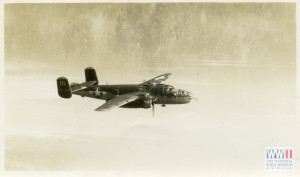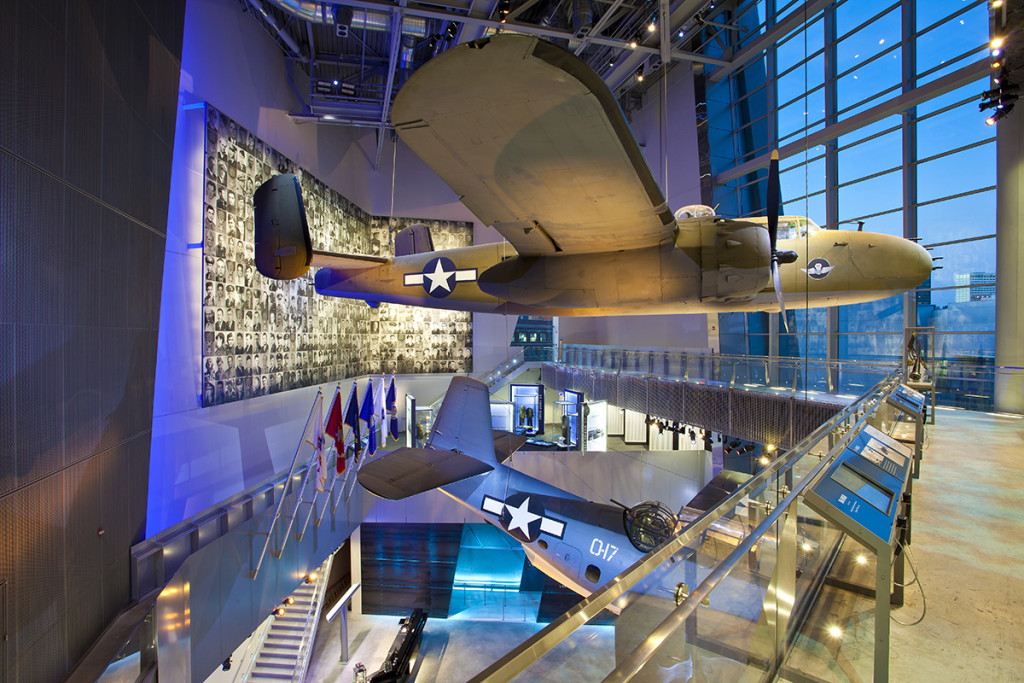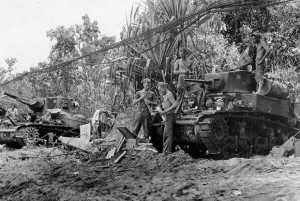Spotlight: B-25 Mitchell and M3A1 Stuart Tank
World War II was characterized by an extraordinary spirit of teamwork, sacrifice and ingenuity demonstrated by men and women on the battlefront and on the Home Front. One of the crowning achievements of the war was America’s legendary production of airplanes, artillery, tanks, and other equipment that helped to fuel victory in World War II. The US Freedom Pavilion: The Boeing Center showcases macro artifacts and features advanced interactive exhibits designed to help visitors understand American wartime ingenuity at its finest. Two highlights of the US Freedom Pavilion is the B-25 Mitchell, an iconic aircraft of World War II known as one of the greatest American bomber planes, and the M3A1 Stuart Tank, a 4-man crew light tank introduced in 1942 and used by the US Army in both the European and Pacific Theaters.

View looking over unto a B-25 Mitchell bomber in flight. Location unknown. 1943-45. Gift of Charles Szumigala, from the collection of The National WWII Museum.
North American B-25 Mitchell
The B-25 bomber gained fame in the daring April 1942 Doolittle Raid on the Japanese Home Islands. Lt. Col. James Doolittle and fellow airmen stunned the Japanese military by penetrating some of the world’s more formidable air defenses, dropping bombs close to the Emperor’s Palace. The Doolittle Raid’s B-25s were the only aircraft to bomb Tokyo until 1944, when B-29 Superfortresses began operating from the Marianas Islands. The B-25 bomber served in every theater of the war, excelling in multiple roles, chiefly as a ground-attack aircraft later in the war. It is the only aircraft in Air Force history to be named after a man, General Billy Mitchell, an early advocate for the strategic importance of air power.
The Museum’s B-25 carries the markings of The 490th Bombardment Squadron known as the “Burma Bridge Busters.” Such planes used innovative bombing techniques to destroy bridges that the Japanese needed to send supplies and reinforcements into Burma. This B-25J “gunship” could also bring 14 forward-firing .50 caliber machine guns to bear on Japanese anti-aircraft defenses that were concentrated around the bridges of Burma. Meanwhile the B-25’s 3,000 lbs. of bombs were dropped on the bridge.
M3A1 Stuart Tank
The US Army began development of a light tank in the early 1930s. After a number of models which progressively increased armor and fire power, the M3 series was initiated in July 1940. Provided to British forces as part of the Lend-Lease agreement, the M3 first saw combat with British forces in North Africa in November 1941. The British found the M3 to be under-gunned, but were so pleased with its mechanical performance they nicknamed it “Honey.”
The M3 saw service with American forces in the Philippines when the Japanese invaded in December 1941. Feedback from these actions led to improvements incorporated in the M3A1, which began production in May 1942, including the addition of a gyro stabilizer for the 37mm main gun and a power traverse for the turret. The addition of the power traverse required the turret to be fitted with a basket or floor which rotated with the turret. This was the first American tank to include such features.
The M3A1 also saw service with American forces during the North African Campaign. The 37mm main gun which had proved inadequate for British forces a year before was now even more ineffective since German armor had continued to upgrade. One veteran noted, “Popcorn balls thrown by Little Bo Peep would have been just as effective” as the 37mm against German armor. Following the 1st Battalion, 13th Armored Regiment’s participation in the Battle of Kasserine Pass, the Stuart tank was relegated to the role of reconnaissance and flank security. The M3 and its successor, the M5, continued to be utilized in Europe through the end of the war.
Although poorly suited to tank warfare in Europe, the Stuart tank proved effective in the Pacific. In New Guinea and the Solomons, the Stuart served in an infantry support role. Although the 37mm gun was not ideal, the small Stuart was much more practical for jungle warfare than the much larger and heavier Sherman that replaced it in late 1943.
- Posted :
- Post Category :
- Tags :
- Follow responses to this entry through the RSS 2.0 feed. You can skip to the end and leave a response. Pinging is currently not allowed.






Leave a Reply